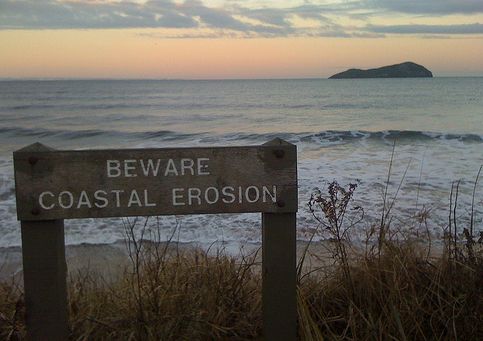For most of the 20th century, Chesapeake Beach, Maryland, was known for its boardwalk, amusement park, and wide, sandy beaches, popular with daytrippers from Washington, D.C. “The bathing beach has a frontage of three miles,” boasted a tourist brochure from about 1900, “and is equal, if not superior, to any beach on the Atlantic Coast.”
Today, on a cloudless spring afternoon, the resort town’s sweeping view of Chesapeake Bay is no less stunning. But there’s no longer any beach in Chesapeake Beach. Where there once was sand, water now laps against a seven-foot-high wall of boulders protecting a strip of pricey homes marked with “No Trespassing” signs.
Surveying the armored shoreline, Jim Titus explains how the natural sinking of the shoreline and slow but steady sea-level rise, mostly due to climate change, have driven the bay’s water more than a foot higher over the past century. Reinforcing the eroding shore with a sea wall held the water back, but it also choked off the natural supply of sand that had replenished the beach. What sand remained gradually sank beneath the rising water.
 Titus, the Environmental Protection Agency’s resident expert on sea-level rise, first happened upon Maryland’s disappearing beaches 15 years ago while looking for a place to windsurf. “Having the name ‘beach,'” he discovered, “is not a very good predictor of having a beach.” Since then, he’s kept an eye out for other beach towns that have lost their namesakes — Maryland’s Masons Beach and Tolchester Beach, North Carolina’s Pamlico Beach, and many more. (See a map of Maryland’s phantom beach towns here.) A 54-year old with a thick shock of hair and sturdy build, Titus could pass for a vacationer in his Panama hat, khakis, and polo shirt. But as he picks his way over the rocky shore, he’s anything but relaxed.
Titus, the Environmental Protection Agency’s resident expert on sea-level rise, first happened upon Maryland’s disappearing beaches 15 years ago while looking for a place to windsurf. “Having the name ‘beach,'” he discovered, “is not a very good predictor of having a beach.” Since then, he’s kept an eye out for other beach towns that have lost their namesakes — Maryland’s Masons Beach and Tolchester Beach, North Carolina’s Pamlico Beach, and many more. (See a map of Maryland’s phantom beach towns here.) A 54-year old with a thick shock of hair and sturdy build, Titus could pass for a vacationer in his Panama hat, khakis, and polo shirt. But as he picks his way over the rocky shore, he’s anything but relaxed.
For nearly 30 years, Titus has been sounding the alarm about our rising oceans. Global warming is melting polar ice, adding to the volume of the oceans, as well as warming up seawater, causing it to expand. Most climatologists expect oceans around the world to rise between 1.5 and 5 feet this century. Some of the hardest-hit areas could be in our own backyard: Erosion and a shift in ocean currents could cause water to rise four feet or more along much of the East Coast. Titus, who contributed to the Intergovernmental Panel on Climate Change’s Nobel Prize-winning reports, has done more than anyone to determine how those rising seas will affect us and what can be done about them.
Like his occasional collaborator, NASA climatologist James Hansen, Titus has decided to speak out. He’s crisscrossed the country to meet with state and local officials in coastal areas, urging them to start planning now for the slow-motion flood. Yet his warnings have mostly fallen on deaf ears. “We were often told by mid-level officials that their bosses did not want to plan for anything past the next election,” he says.
Neither, it seems, does the federal government. Over the past decade, Titus and a team of contractors combined reams of data to construct a remarkably detailed model of how sea-level rise will impact the eastern seaboard. It was the largest such study ever undertaken, and its findings were alarming: Over the next 90 years, 1,000 square miles of inhabited land on the East Coast could be flooded, and most of the wetlands between Massachusetts and Florida could be lost. The favorably peer-reviewed study was scheduled for publication in early 2008 as part of a Bush Administration report on sea-level rise, but it never saw the light of day-an omission criticized by the EPA’s own scientific advisory committee. Titus has urged the more science-friendly Obama administration to publish his work, but so far, it hasn’t-and won’t say why.
So Titus recently launched a personal website, risingsea.net, to publish his work. “I decided to do my best to prevent the taxpayer investment from being wasted,” he says. The site includes “When the North Pole Melts,” a prescient holiday ditty recorded by his musical alter ego, Captain Sea Level, in the late ’80s.
Titus gazes at Chesapeake Beach’s jagged shoreline, where two children scramble over the barrier of large grey boulders known as a revetment. “The children of 21st Century Chesapeake Beach, what do they do?” he asks. “They play on revetments.” A generation ago, these kids might have been skipping through the waves. A generation from now, many of the rocks they’re playing on will almost certainly be underwater.
Living near the ocean has always come with the risk of getting wet. Yet coastal dwellers whose homes got swamped by the occasional storm surge could rely on the water to eventually recede. That certainty is gone. Titus has calculated that a three-foot rise in sea level will push back East Coast shorelines an average of 300 to 600 feet in the next 90 years, threatening to submerge densely developed areas inhabited by some 3 million people, including large parts of New York City, Philadelphia, and Washington, D.C. As Margaret Davidson, director of the National Oceanic and Atmospheric Administration’s Coastal Services Center in Charleston, South Carolina, puts it, “Today’s flood is tomorrow’s high tide.”
The rising waters can be kept at bay by constructing dikes and bulkheads, pumping sand to fill out receding beaches, and elevating existing buildings and roads on embankments or pylons. But such efforts may prove prohibitively expensive — Titus says that in the lower 48 states alone, they could cost as much as $1 trillion over the next century, and he estimates that in the process, 60 to 90 percent of the East Coast’s wetlands could be destroyed as bulkheads and other defensive measures restrict the movement of estuaries and marshes, drowning them when the ocean rises.
So are developers getting ready for the water? The National Association of Home Builders, the housing industry’s largest trade group, has no policy on adapting coastal projects to account for rising sea levels. “While sea level rise may be a real issue in some areas,” Susan Asmus, NAHB’s senior vice president of regulatory and environmental affairs, told me in an email, “it is but one of many considerations that are likely already taken into account during the planning process.” Mother Jones contacted the nation’s 10 largest homebuilders, including D.R. Horton, Pulte Homes, and Lennar; none would say how they are responding to sea level rise.
Nor is there any evidence that the issue has much traction with homeowners — and why should it? Property insurance is readily available in most coastal areas, if not through private insurers, then through state governments and FEMA’s National Flood Insurance Program. Though the NFIP requires policyholders to live above the 100-year high-water mark, it doesn’t account for how that line may creep inland in the future. Besides, most people would plan to resell their beach houses long before they expect them to be swallowed by encroaching waves.
What about government? Most coastal states have done little or nothing to regulate shoreline development, often for fear of litigation. In 1988, South Carolina’s Beachfront Management Act required new beach homes to be set back far enough from the water to be protected from at least 40 years of erosion. A property owner named David Lucas sued, and the U.S. Supreme Court eventually ruled that the construction ban had deprived him of any “economically viable use” of his coastal properties, a “taking” that required the state to compensate him. “After Lucas, fewer people spoke seriously about stopping development,” Titus says.
A few state and local governments have taken more constructive action. Several states limit development near tidal waters (Maine and Rhode Island have done this specifically in response to sea-level rise). Chatham, Massachusetts, cites sea-level rise as one reason why it prohibits new homes, even elevated ones, below 100-year flood lines. (State courts have upheld those limits in Chatham and Maine because they still allow property to be used for recreation, farming, and other profitable activities.) In California, where erosion and winter storms routinely knock multimillion dollar homes off seaside cliffs, the state’s Coastal Commission has long required anyone who builds on coastal bluffs to submit a geotechnical report proving that their home won’t fall into the ocean. Three years ago, it began requiring the reports to account for sea-level rise. And in a groundbreaking 2008 executive order, Governor Arnold Schwarzenegger directed state agencies to plan for sea-level rise in their construction projects.
A handful of developers have also started to seriously grapple with sea-level rise. A residential high-rise project on Treasure Island, a former naval base in the San Francisco Bay, is being built far from the shoreline and is reserving funds for a protective berm if the water rises even higher than the three feet that’s anticipated. And in the wake of Hurricane Katrina, the insurance industry drew up standards to fortify houses for stronger hurricanes and higher waves; so far, though, only 200 houses nationwide have been built to comply with the standards.
Most coastal dwellers are focused on riding out the next surge, not the next century. You can’t really blame them — nobody really wants to hear that their days on the beach are numbered.
Case in point: Beyoncé’s dad. Matthew Knowles has been locked in a bitter struggle to save his beach house in Galveston, which now sits on top of the high-tide line thanks to Hurricane Ike. In most states, Knowles would be allowed to shore up his home, but not in Texas, which is known for one of the most progressive laws in the country on beach access. The state’s Open Beaches Act provides that beach as a public resource that must be protected from “erosion or reduction caused by development.”
Last year, after Knowles started reinforcing his property with tons of cement, the Texas General Land Office informed him that paving over the beach is illegal. Even so, he continued and then surrounded his home with sod, planters, and sandbags. In March, the agency notified Knowles that it was preparing to fine him up to $2,000 a day for violating the Texas Open Beaches Act by interfering with “the right of the public to use the beach.” Knowles did not respond to a request for comment.
Historically, the 51-year-old law has been used to prevent property owners from walling off the beach in front of their homes. But officials say the law clearly applies even when the beach comes to the houses, rather than vice versa. “Even if you make $80 million a year, we don’t care,” says Jim Suydam, a spokesman for the Texas General Land Office. “The beach is the public’s.” Incorporated into the state constitution last year and vigorously supported by the state’s conservative, gun-packing land commissioner, the Open Beaches Act is remarkably popular, in part because it can guarantee beach access for ATVs.
Titus views the Texas Open Beaches Act as one of the more promising tools for preparing for higher water. It has unintended environmental benefits, ensuring that beaches can migrate inland instead of being walled off — and at the same time, it sidesteps any debate over climate change. “Developers who deny that the sea will rise would view the policy as costing them nothing,” because it wouldn’t prevent them from building near the shore, he notes. Only the diehard beach dwellers would stand to get soaked.
With additional reporting by Kate Sheppard.





